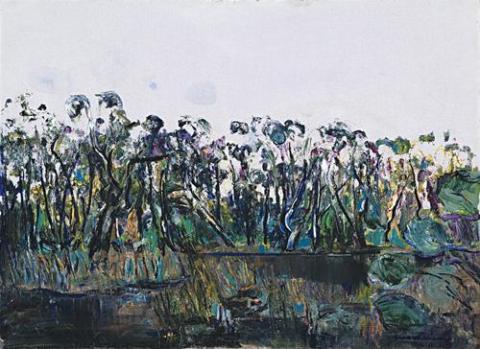LANDSCAPE WITH SWAMP, 1972
Fred Williams
oil on canvas
71.5 x 97.0 cm
signed lower right: Fred Williams artists label attached verso: artist, title, date, medium and inscribed: Willesmere Park (KEW) / Painted on 6 August 1972
Rudy Komon Gallery, Sydney (label attached verso)
Gould Galleries, Melbourne
Private collection, Melbourne
From Streeton to Whiteley: A Selection of Australian Art, Gould Galleries, Melbourne, 18 October – 10 November 1996, cat. 29
The 1970s introduced some of Fred Williams' pictorially richest and most interesting works, as seen in Landscape with Swamp. From the aerial viewpoint and minimalism of the You Yang paintings and the tripartite divisions of his later Lysterfield paintings, his work gave way to the freer compositions and richer colours of the Yan Yean oils of 1972, painted out of doors at the Yan Yean Swamp in company with John Perceval. Unlike earlier works, they are clearly identified with the place and its particularities, being described by Patrick McCaughey as 'among the finest and most interesting of all the oil sketches of the early 1970s.'1 Although inspired by a different place, Landscape with Swamp belongs to this group in terms of motif and achievement. Now more traditional in pictorial presentation, the brilliance of palette and vitality of form gains in emphasis through the use of black, outlining tree trunks and water's edge. It provides an element of control, as it were, for the rich tangle of colour and paint, seen again in such works as Yan Yean II (Dog Chasing Possum) and Yan Yean in the collection of the Queensland Art Gallery, both painted in 1972.
Landscape with Swamp is identified by the artist's note on the back of the painting as Willesmere Park in Melbourne's East Kew, close to the Kew Billabong and River Yarra. Williams even added the date on which it was painted, indicating that both location and time had significance in terms of the painting itself during this highly fertile period of his art. While the locale is different from Yan Yean, the motif is similar and marks the genesis of the great Kew Billabong series of three years later. Previously it had been thought that Williams commenced this series in April of 1975.2 Williams considered the Billabong 'splendid' and found 'it a great place to work.'3 It was within easy distance from his home and provided Williams with what McCaughey described as 'a retreat, a new starting point with some point of departure from previous work'4 Quiet paintings of the transitory illusion of light reflecting on water and thoughts of Monet's Waterlilies led many to see these paintings as being 'as close to the spirit of French Impressionism as any of Williams's works'5 Such developments to come are hinted at in Landscape with Swamp, where the splendidly vigorous handling of the monumental in nature is destined to give way to the intimate. The ephemeral detritus of man and nature were to replace the grandeur of trees beside the bank and their solid reflections in the water.
1. McCaughey, Patrick, Fred Williams, Bay Books, Sydney, 1980, p. 240
2. Mollison, James, A Singular Vision: The Art of Fred Williams, Australian National Gallery, Canberra, 1989, p. 199
3. ibid.
4. McCaughey, op.cit., p. 285
5. Mollison, op.cit., p. 201
DAVID THOMAS
